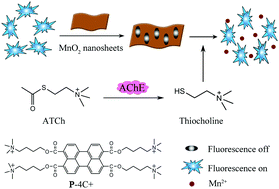A real-time fluorescence turn-on assay for acetylcholinesterase activity based on the controlled release of a perylene probe from MnO2 nanosheets†
Abstract
We exploit a real-time perylene probe fluorescence turn-on method to detect acetylcholinesterase (AChE) activity through the selective decomposition of MnO2 nanosheets. The surface of the MnO2 nanosheets is negatively charged. The perylene probe (P-4C+) has four positively charged quaternary ammonium groups. When mixed together, P-4C+ attached to the surface of the MnO2 nanosheets through electrostatic attractive interactions. The fluorescence of P-4C+ was effectively quenched by the MnO2 nanosheets. Acetylthiocholine (ATCh) could be hydrolyzed to thiocholine by AChE. Thiocholine is a reducing agent. It could reduce MnO2 nanosheets to Mn2+ and thus trigger the decomposition of the MnO2 nanosheets. As a result, P-4C+ was released and the fluorescence of P-4C+ was restored. The AChE inhibitor restrained the catalytic activity of AChE and resulted in a reduced fluorescence recovery of P-4C+. Our assay method is simple and selective, with low toxicity and better biocompatibility, which would facilitate biological and biomedical applications associated with AChE activity.



 Please wait while we load your content...
Please wait while we load your content...